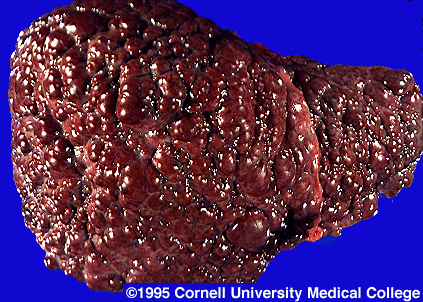Hepadnaviridae
· Small, enveloped, dsDNA (partially ssDNA) viruses.
· The name hepadna comes from the infection of the liver—hepatitis—by a DNA virus.
· Hepadnaviruses can cause chronic liver infections in humans and other animals, including ducks. In humans the hepatitis B virus causes hepatitis B, which can progress to liver cancer.
Hepatitis B Virus
http://pathmicro.med.sc.edu/lecture/hepatitis.gif
Important properties
· 42-nm enveloped virion
· Icosahedral nucleocapsid core contains a partially double-stranded circular DNA genome.
· Envelope contains a protein called the surface antigen (HBsAg).
· Core antigen (HBcAg) and the e antigen (HBeAg) are both located in the nucleocapsid protein but are antigenically different.
· Endogeneous DNA-dependent DNA polymerase within the core.
· Use of overlapping reading frame (ORF).
· RNA-dependent DNA synthesis during replicative cycle.
Pathogenesis
· Acute or chronic liver infection depending on the age at infection.
· 90% of neonates and 50% of young children become chronically infected.
· Only about 5% to 10% of immune-competent adults infected with HBV develop chronic hepatitis B.
· A chronic carrier is someone who has HBsAg persisting in their blood for at least 6 months.
· A high rate of heptatocellular carcinoma occurs in chronic carriers.
Basic characteristics of Hepatitis B infection:
| Incubation period | 60-90 days* |
| Fatality rate | 1% |
| Recovery Rate | 90% |
| Rate of Chronic Infection | <10%** |
*with a range of 45-120 days
**although this can approach 90% in babies infected with HBV at birth.
http://www.medscape.com/content/2004/00/47/14/471470/art-jvh471470.fig2.gif
Above: The natural history of Hepatitis B
Clinical Features
Acute
· Loss of appetite, nausea, vomiting, fever, abdominal pain and jaundice
· About 90% - 95% of adults recover without sequelae
· 5% - 10% become chronically infected
Chronic
· While some chronic carriers will show clinical symptoms, most are asymptomatic—
they show no symptoms and may show no abnormalities on laboratory testing but remain infectious.
· Some chronic carriers have chronic active hepatitis. This can lead to cirrhosis (the inflammation and hardening of the liver), hepatocellular carcinoma (primary liver cancer), and death.

http://www.stanford.edu/group/virus/hepadna/2004tansilvis/liver%20cirrhosis.gif
Laboratory Diagnosis

· Quick detection for early HBV infection: immunoassay for HBsAg
· HBsAg appears during the incubation period and is dewtectable in most patients during the acute disease. It falls to undetectable levels during convalescence in most cases
· Prolonged presence of HBsAg indicates the carrier state and the risk of chronic hepatitis and hepatic carcinoma.
· HBeAg is also detectable in acute infection which is characterized by a high rate of viral replication.
· IgM antibodies against core antigen are detectable in serum.
· Seubsequently, IgG antibodies against core are produced, and persist for life.
· If the diagnosis of hepatitis B is confirmed, a prognosis may be assessed by liver biopsy.
Transmission
· Through contaminated blood.
· Sexual intercourse with an infected person. (horizontal transmission)
· Perinatally from infected mother to newborn. (vertical transmission)
Epidemiology and Control
http://www.dshs.state.tx.us/idcu/disease/hepatitis/hepatitis_b/faqs/hepbdstb.gif
· Estimated 400 million people worldwide infected with HBV.
· Post 1987 babies all vaccinated against HBV.
· Pre 1987 screening ongoing.
· People at risk
o Doctors, laboratory workers, personnel coming in contact with blood.
o Drug addicts who share needles.
o Promiscuous behaviour.





0 comments:
Post a Comment